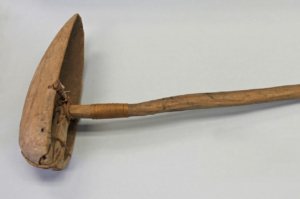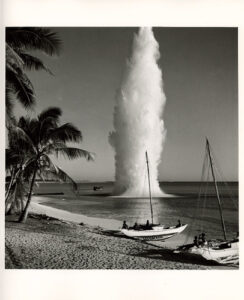medinites.com/deephistory
Pacific Migration, Existence, and Paradox: A Deep History
Our final object of analysis includes a canoe bailer from Bikini Atoll in the Marshall Islands of Micronesia (slightly southeast of Hawai‘i) in 1946. In presenting this object, which was used by Micronesian natives to remove water from their canoes in a process known as bailing, we move on from the (relatively recent, by deep historical standards) ancestral Oceanic culture of the Lapita; past the settlements of various Pacific islands, including most notably Aotearoa and Hawai‘i; and directly into the post-World War II era and its associated contemporary issues of concern.
The bombings of Hiroshima and Nagasaki on the Pacific island of Japan are an obvious image of destruction, and a narrative so visibly etched into any American high school education. Left secondary to that narrative, however, is that numerous world powers - in particular, the United States - afterwards used the waters and lands of the Pacific as a space to test generations of atomic weapons with even greater explosive yields; researchers and military officials alike used the Pacific Ocean as a laboratory to investigate the after-effects of nuclear weapons, mushroom clouds, and other high-potency items.
Even more unspoken in that narrative includes the dislocation of islanders who once called those now atomic-atolls home, peoples who would have once used this wooden object in order to scoop water out of their canoes; one scholar of the Pacific writes that in the wake of World War II, the United States developed a so-called Trust Territory of the Pacific Islands in order to assume a legal right to forcefully remove and dispossess islanders for nuclear testing means. This issue has since re-emerged in the twenty-first century, with recent scholars framing the “drenching” and forced resettlement of the Marshall Islands as an issue central to human rights and environmental justice.
The provenance of this object speaks to all of these themes and more. It arrived to the Pacific coastal city of Los Angeles recently via a donation that specifically hoped to memorialize the removal of the indigenous populations of Bikini Atoll. The museum had to test the objects for radioactivity; visitors with a Geiger counter will find that this object is safe for viewing.
An alternative object related not to the to the Nuclear Age but rather to climate change likely would have raised similar thematic points; the climate’s impacts on the Pacific Ocean and the resettlement of its peoples, however, is already studied aplenty, and that argument has also already been covered by other deep historians of the ocean time and time again. "Pacific Migration, Existence, and Paradox: A Deep History" thus asserts the spectre of the atomic actor over the canoe dweller to be much more compelling and historiographically novel to the Pacific Islands anthropological discipline. After all, the sea levels rise and glaciers melt at a steady but slow and non-instantaneous pace; the atom, by distinctive contrast, offers Pacific Islanders and non-Pacific Islanders alike no such mercy.
To continue a cynical analysis of this issue, nuclear weapons ultimately changed little of how humans engaged with the Pacific over deep historical time. In bringing human-created environmental destruction as well as human dispossession and resettlement to the ocean, what else is new? Thus, our gallery argument ends on a darkly existentialist (albeit thematically fitting) note.
The ABCs:
Atom Bombs, Bikini Atoll, and Canoe Bailers
Non-radioactive Canoe Bailer
Bikini Atoll, Marshall Islands
c. 1946
National History Museum of Los Angeles County
[Bonus Material: A Photo From Ground Level]
Paper Photograph of Nuclear Testing on Bikini Atoll, Marshall Islands, 1946
Smithsonian National Museum of American History
Photographer: Carl Mydans
Smithsonian National Museum of American History
Photographer: Carl Mydans

